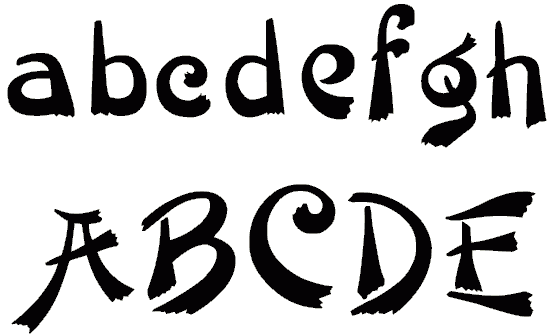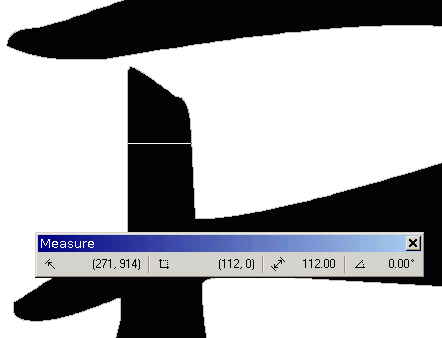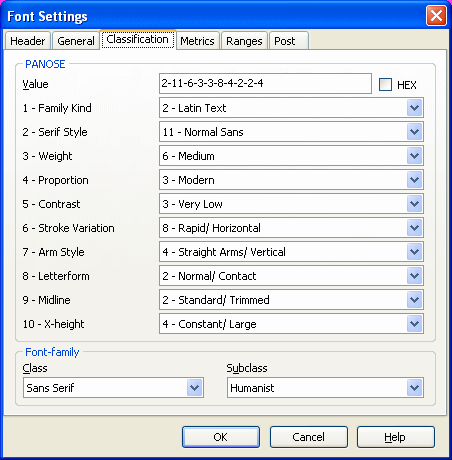Do you ever get frustrated searching through your collection for just the right font?
Do you need/want a sorting or classification scheme for your font collection?
There have been many machinations proposed. It is easy to end up with too few, or too many font buckets in schemes, so
instead of searching through 10,000 fonts, you end up searching through 20,000 buckets.
Surprise! There is a sorting system already built into each of your TrueType (TTF) Fonts and Open Type (OTF) Fonts!
It is named PANOSE, and it is used by most commercial font foundrys.
Part A
Q. What is Panose?
A. A Panose Number consists of a ten digit number, each digit containing a value between 0 and 15. I'm using hexadecimal numbers (0-9, A-F) inserted into the OS/2 Table of the Rich Font Description (RFD) incorporated into each True Type font. It was invented to speed up printers by minimizing the number of fonts required in the printer memory. For more information see the NOTES at the end of this tutorial.
Examples:
[attachment=1]PanExamples.jpg[/attachment]
Topology????
Topology -Math. The study of those properties of geometric forms that remain invariant under certain transformations, as bending or stretching.
As far as I know, ALL Non Latin fonts have yet to be classified, so they should be placed in the “No Fit” category of 1111111111.
However, most fonts with other PANOSE numbers contain Non Latin characters in their Supplementary Multilingual planes. See: viewtopic.php?t=386
Q. Why should I care?
A. 1. Many of your applications use Panose to replace damaged or absent fonts in documents. If you don’t reset the numbers when you build a new font, they remain set at 0000000000, Which means the font contains no Panose information, so it can NOT be used to replace any other missing or damaged font.
Usually Arial, Courier, or Times New Roman will be selected instead of your font.
2. Most of your collected fonts will remain jumbled at the bottom of the pile when you do a Panose or Similar search for them.
With FC you can embed Panose Numbers to make them available to Explorer and MainType searches.
3. It gives that special Professional Touch to your fonts.
In their Introduction, Monotype states:
So if YOU want to use the Panose spaces to set up your own system, do it!Hewlett-Packard does not restrict the use of PANOSE Classification Numbers in typeface products developed by third parties.
FONT COLLECTORS: PANOSE can be used to identify "holes" (missing font styles) and duplicates or knock-offs!
To see Panose in action: if you are using Windows XP, Select My computer (or press Start), Control Panel, Fonts.
You will be presented with four choices for looking at your font files. We are now interested in choice 3, Similar. Yeah, the icon with AB on it. Select Similar then pick a font from the box “List fonts by similarity to:” by pressing the down arrow. Look at the results. Select another font that is not similar to the one you were just examining. Interesting, huh!
The PANOSE numbers embedded in the fonts are used to make these comparisons.
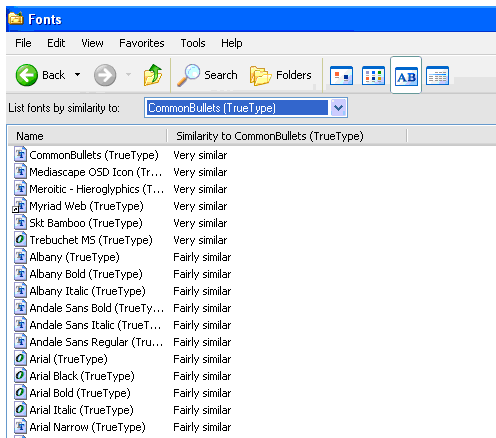
Do you think Common Bullets looks anything like Arial? I think Common Bullets should have gone into section 5 instead of section 2.
Obviously “similar” is in the eye of the “Panoser.”
Most of my favorite fonts are always at the bottom of the list with the notation “No PANOSE information available.”
Hmmm, Why is that? Could it be that the font creators never bothered to insert the Panose Numbers?
Conclusion: If you get your PANOSE straight, your fonts will join all the other good little fonts. What a concept!
An excellent way to use the Panose Numbers to sort/compare/select your fonts is High-Logic's very nice program MainType.
Go to http://www.high-logic.com/download.html for a free trial.

MainType gives you your choice of 4 pre-selected Information layouts AND the option of moving things around any way you want and saving an additional two options.
I selected the Panose setting under Columns and moved it to the top of the list. Also, under Information, I opened the Classification subheading for this presentation.
Note that Ancestry SF was not given a Panose number. It should at the very least begin with a 3.
Also note that MainType allows many other ways to search for a particular font! Just click on ANY column head to resort by that information.
MainType allows you to easily move fonts into any group folder/file system you chose with or without Panose.
Panose doesn't work as a truly great classification system (after all, it is NOT in the order I would have chosen AND you would want something different than what I want) because that isn’t precisely what it was created to do.
Perfection is a matter of opinion!
It is hard work to perfectly encode Panose. Then, even when we go to the trouble, it doesn't give us the differentiation we need.
Most font collectors choose buckets labeled by themes such as Engraved, Stencils, Medieval, kid hand; or pictorial themes such as African Art, Valentines, Christmas, Flowers, et al. They prefer to put all their text fonts into just one or two buckets, perhaps dark or light, one bucket for Serif, another for Sans Serif is usually enough. They usually don't care about obtuse cove, square cove or obtuse square cove.
But then again, Panose is there, and it works quite well, so why not use it?
EDIT 07 Jan 2010:
How I use Panose: I created a Font Folder with a sub folder labeled Panose and sub-sub folders for the first two digits and just visually tossed in the fonts I really like. Feel free to copy and print the following image.
A more complete single page version is at:
postedfiles/Panose.pdf
Boring Fonts are in alphabetical folders.
Perhaps some day I'll take time to correct the Panose numbers, but for now I can quickly and easily find the font I want for most projects.
Q. How do I “Panose?”
A. The easy way is to use FontCreator:
1. Open a font similar to yours that contains Panose information.
Select Format, Settings, Classification, and jot down the information you find on the Value Line.

NOTE: "Font-family" at the bottom of the window is IBM's Classification scheme.
2. Open your font, Format, Settings, Classification, and enter the information where your font is the same as the other.
You have two choices:
1. Type the numbers in directly on the Value Line in Hex or decimal, or
2. Select from the list below the Value Line and let Erwin do the work.
Remember, if you want to make up your own system, just type in whatever you want on the Value Line.
3. You may wish to check the first three digits with the information in Part B, below.
4. If you wish to do more, go to the appropriate Panose web page To figure out whatever adjustments you need to make to your font Panose Numbers.
Part B
A brief introduction to Assigning PANOSE Numbers
Beyond the first 3 digits, it can get complicated/confusing. But then, 3 correct digits is MUCH better than 0000000000, and Erwin made it easy for you to GUESS at the rest if you have to, and do quite well.Caution on measurements: When measuring a design with a highly rounded or bowed inside stem, be certain to calculate the correct theoretical edge for the location of the stem edge. Curved stems can alter the measurements for classification significantly enough to alter the resulting category. A face such as Optima can classify quite differently if the W Stem is incorrectly measured at the narrowest or widest portion of the stem.
The first digit, Family Kind, is the Most Important Digit!
At present, only 6 (0-5) digits are used in the space for the first digit:
For more information on the first digit 1 see:
Note: http://www.panose.com/printer/pan1.asp has been redirected to:
http://www.panose.com/ProductsServices/pan2.aspx
From here on, there is a two step process to decide which group a font belongs in:
Step One.
Answer the following three questions.
1. Does the font belong to a family that includes italic versions?
2. Are the characters in the font made up of standard topologies constructed of standard parts?
3. Is some portion of the font suitable for composing a paragraph of text?
Step Two.
If the answer is yes to all three, then the font belongs in Latin Text - Section 2
(where Serif Style is most important).
If there are any no's, look at the Second PANOSE Digit of the
Handwritten (Script)-Section 3 (where Tool Kind is most important) and
Decorative -Section 4 (where Class - Topology and Decoration - are most important)
families to see if there is a better fit to the question.
IF the answer to question #3 is NO, the font belongs in Symbol -Section 5.
(Remember Common Bullets?)
Edit Note 21 Jan 2008
Since writing this tutorial almost three years ago I've found many people have a problem with this first step.
In plain words, you only need to consider 4 first Pan Digits:
However, many "pictorial fonts" have images placed in alphanumeric edit windows and could be classified as Pan 4 as they were not classified as Symbol Fonts.
- Pan 2 = alphanumeric fonts consisting of more or less standard serif and sans serif shapes.
Usually a LOT of design work has gone into the mechanical angles, shapes, and spacing for recognition and legibility considerations.
Pan 3 = alphanumeric fonts YOU think would have been made with specific tools (charcoal, paint brush, felt tip, engraving tool, etc) out in the "Real World" and the Designer Decision is final.
These fonts are looser, free flowing and less exacting than 2's. All Hand Scripts belong here unless they are "overly ornate," whatever that means.
Pan 4 = either Pan 2 or Pan 3 fancied up in some way.
Pan 5 = those fonts that are not alphanumeric in character.
(rhetorical question) Does that help?
Also, some Web Locations have changed and are noted in RED.
The succeeding digits convey:
2. Serif Style, 3. Weight, 4. Proportion, 5. Contrast, 6. Stroke Variation, 7. Arm Style, 8. Letterform, 9. Midline, 10. X-height
Latin Text: Second Digit (2.2) = Serif Style. “The most sophisticated digit in the PANOSE classification system”
includes both Serif and Sans Serif typefaces.
Dump your font into the hopper, turn the crank and see what slot your font falls through.
"Transitional Serifs" Flared and Rounded belong in either group depending on base to stem ratios.
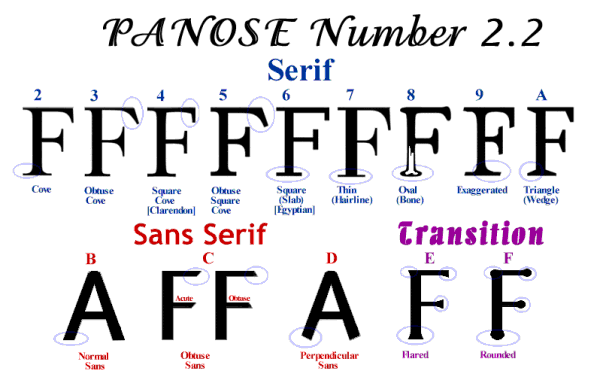
20 = Any (Don’t use.)
21 = No Fit (Last Resort.)
22 = Cove (default for Serif) Serif joins stem with a curve.
23 = Obtuse Cove Serif attaches at an obtuse angle
24 = Square Cove
25 = Obtuse Square Cove
26 = Square AKA Slab or Egyptian
27 = Thin AKA Hairline
28 = Oval Previously "Bone"
29 = Exaggerated
2A = Triangle AKA Wedge
2B = Normal Sans (default for Sans Serif) Bottom of "A" stem parallel to base line
2C = Obtuse Sans BOTH Obtuse and Acute are included.
2D = Perpendicular Sans Bottom of "A" stem strikes base line at angle greater than 15 Degrees.
2E = Flared Stem widens at base. Narrow = Sans, Wide = Serif
2F = Rounded Stem is rounded at base. Narrow = Sans, Wide = Serif
Latin Text Third Digit (2.3) = Weight.

png Courtesy Bhikkhu Pesala
FYI: Lucky for Panose Sections 2.3, 3.3, and 4.3, the calculations for weight are among the easiest to compute.
There are specific letters used for measuring weight:
CapH is the Height of the capital H.
WStemE is width of the stem of the capital E.
WeightRatio = CapH / WStem(E)
Thin Stems will return large Rat (Ratio) numbers.
Thick stems will return small Rat numbers.
Many designers appear to just throw a dart. Perhaps that is good enough.
Code: Select all
2_0 = Any (Don't use.)
2_1 = No Fit (Don't Use)
2_2-Very Light....................WeightRat ≥ 35 (35 or greater)
2-3-Light....................18 ≤ WeightRat < 35 (18 or greater, less than 35)
2_4-Thin.....................10 ≤ WeightRat < 18
2_5-Book....................7.5 ≤ WeightRat < 10
2_6-Medium..................5.5 ≤ WeightRat < 7.5
2_7-Demi....................4.5 ≤ WeightRat < 5.5
2_8-Bold....................3.5 ≤ WeightRat < 4.5
2_9-Heavy...................2.5 ≤ WeightRat < 3.5
2_A-Black...................2.0 ≤ WeightRat < 2.5
2_B-Extra Black...................WeightRat < 2NOTE: http://www.panose.com/printer/pan2.asp has been moved to:
http://www.monotypeimaging.com/Products ... /pan2.aspx
The succeeding digits convey:
2. Tool Kind, 3. Weight, 4. Spacing, 5. Aspect Ratio, 6. Contrast, 7. Topology
8. Form, 9. Finials, 10. X-ascent

Latin Hand Written (Script) Second Digit (3.2) = Tool kind
30 = Any (Don’t use.)
31 = No Fit (Last Resort)
32 = Flat Nib
33 = Pressure point
34 = Engraved
35 = Ball (Round Cap)
36 = Brush
37 = Rough
38 = Felt Pen/Brush Tip
39 = Wild Brush - Drips a lot
Latin Hand Written. Third Digit (3.3) = Weight. Same as calculating 2.3.
3_0-Any (Don’t use.)
3_1-No Fit (Last Resort)
Etc.
For more information on this family see:
NOTE: http://www.panose.com/printer/pan3.asp has been moved to:
http://www.monotypeimaging.com/Products ... /pan3.aspx
The succeeding digits convey:
2. Class, 3. Weight, 4. Aspect, 5. Contrast, 6. Serif Variant, 7. Treatment,
8. Lining, 9. Topology, 10. Range of Characters
Latin Decorative.Second Digit (4.2) = Class. Classify faces by using the lowest reasonable digit.
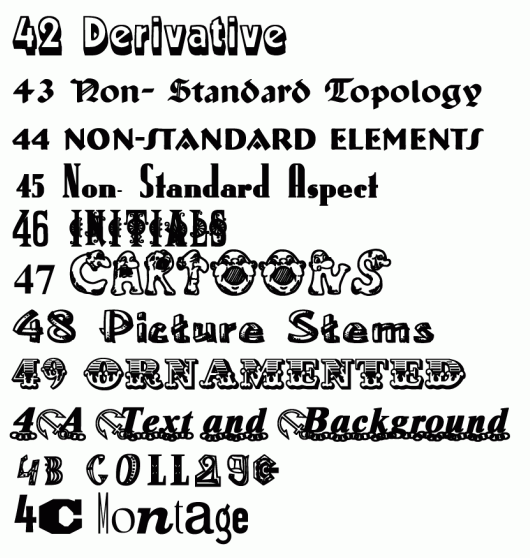
40 = Any (Don’t use.)
41 = No Fit (Last Resort)
42 = Derivative Decorative fonts built on standard text forms
43 = Non-standard Topology Unusual forms for entire letters but still uses standard stems
44 = Non-standard Elements Usual forms but unusual treatments of parts of them, such as serifs or ascenders.
45 = Non-standard Aspect Usual letter forms but unusual proportions such as very high or very low waists.
46 = Initials Typefaces with majuscule (uppercase) characters only.
47 = Cartoon Each entire letter is made up of a single picture that forms the outline of the character.
48 = Picture Stems Each stem is made up of a picture or pictures and the letters made from groups of these elements.
49 = Ornamented Typefaces have additional flourishes and details added to the character.
4A = Text and Background faces have the characters displayed as the absence of pattern on a patterned background
4B = Collage faces have the characters made up of repeating nonstandard elements
4C = Montage faces have the characters made up of non-repeating nonstandard elements.
Latin Decorative. Third Digit (4.3) = Weight. Same as calculating 2.3.
4_0-Any (Don’t use.)
4_1-No Fit (Last Resort)
Etc.
For more information on this family see:
NOTE: http://www.panose.com/printer/pan4.asp has been moved to:
http://www.monotypeimaging.com/Products ... /pan4.aspx
The succeeding digits convey:
2. Kind, 3. Weight, 4. Spacing, 5. Aspect Ratio & Contrast, 6. Aspect Ratio of Character 94, 7. Aspect Ratio of Character 119,
8. Aspect Ratio of Character 157, 9. Aspect Ratio of Character 163, 10. Aspect Ratio of Character 211
5 = Latin Symbol. Second Digit (5.2) = Kind.
50 = Any (Don’t use.)
51 = No Fit (Last Resort)
52 = Montages A mixture. No single type of symbol is more that 50% of the total set.
53 = Pictures Religious symbols, hands, feet, hardware, flowers, buildings, clocks etc.
54 = Shapes Abstract shapes like arrows, boxes, squares, dots, stars, etc. (Common Bullets?)
55 = Scientific Math, Greek letters, differential segments, etc.
56 = Music Notes, clefs, sharps, flats, trills, etc.
57 = Expert Specialized ligatures, groups of small caps, etc
58 = Patterns Line fill symbols, textures, etc.
59 = Boarders Simple or fancy corners and boarder sections.
5A = Icons Block illustrations and symbolic shapes.
5B = Logos Copyrighted logos and registered artwork
5C = Industry specific Engineering, law, medicine, Road Signs, etc.
5 = Latin Symbol. Third Digit (5.3) = Weight. This one IS different!
5_0 (Don’t use.)
5_1 = No Fit The Weight digit is required by the PANOSE engine, but is not meaningful for symbol faces,
so the third digit is ALWAYS set to 1.
For more information on this family see:
NOTE: http://www.panose.com/printer/pan5.asp has been moved to:
http://www.monotypeimaging.com/Products ... /pan5.aspx
In Conclusion, You will find many of your collected fonts have not been "Panosed," or have been given the wrong Panose number. Here is your chance to correct them.
______________________________________________________________
Notes:
This tutorial would have been impossible without the assistance of Dick Pape, Erwin Denissen & Bhikkhu Pesala.
Major Sources of Information:
http://www.myfonts.com/person/bauermeister/benjamin/
http://www.panose.com/printer/pan1.asp through
http://www.panose.com/printer/pan6.asp
http://www.w3.org/Printing/stevahn.html
http://www.w3.org/Fonts/Panose/pan2.html
http://msdn.microsoft.com/library/defau ... t_48aa.asp
http://style.cleverchimp.com/corestyle/ ... -font.html
A Manual of Comparative Typography: The Panose System (Paperback)
by Benjamin Bauermeister
* Paperback: 257 pages
* Publisher: Van Nostrand Reinhold (October 1987)
* Language: English
* ISBN: 0442211872
It was developed by Benjamin Bauermeister, who was born in St. Louis, Missouri, in 1960. In 1990 he was the co-founder with Clyde McQueen of ElseWare Corporation in Seattle, where he first revealed his PANOSE1 Typeface Matching System which began as a 7 digit number. Each succeeding digit breaks the font collection down into ever smaller groups.
Hewlett Packard Co. Soon purchased Elseware Co. And expanded PANOSE to ten digits, each containing a value varying from 0-15 which works great in Hexadecimal. HP created a PANOSE ENGINE that compressed font information into 2 KB packets and incorporated the Panose Numbers into their Agfa Monotype typefaces to identify which packet should be used with which font. Then they designed their printers so that instead of using an entire font, they just sent the number. The printer memory did the math and reproduced a simulation of the font. In other words, the PANOSE numbers told the printers how to draw the typeface.
Some improvements were made and Panose1 became Panose2.
The Panose Numbers have even been used to generate NEW fonts.
HP began reaching out for Partners to make PANOSE an industry wide standard.
Panose Partners have included: AGFA (MonoType); Hewlett Packard Co. (FontSmart); Adobe Corp. (PageMaker); Bitstream Inc.; Caere Corp.; Corel Corp. (CorelDRAW); Lotus Development Corp.; No Hands Inc. (Common Ground); and Microsoft Corp (Word Pro).
We suspect the word PANOSE is an acronym for the full name of the process, but then again, perhaps it is just derived from:
Perhaps the word was chosen to imply that Panose Numbers describe the “full cloth” of typeface possibilities.pannose <botany> Similar in texture or appearance to felt or woolen cloth.
Etymology: 19c: from Latin pannosus, from pannus cloth.
So far as I know, there is presently no PANOSE 3 under construction, but .. . “Who knows what evil lurks in the hearts of ...”
Section 6 states: The tolerances of the weight classification have been determined by testing a variety of fonts. While this has provided reasonable averages for the ranges of weights, these will not always directly correspond with a font’s external name. It is not uncommon to have a font that contains the word “Bold” in the name that actually classifies as 7-Demibold, etc.
In addition, certain families that have a surplus of font weights may not progress smoothly through the differing classification options. It is, however, rare that two members within the same family will have two weights that exist in the same classification category.
Caution on measurements: When measuring a design with a highly rounded or bowed inside stem, be certain to calculate the correct theoretical edge for the location of the stem edge. Curved stems can alter the measurements for classification significantly enough to alter the resulting category. A face such as Optima can classify quite differently if the W Stem is incorrectly measured at the narrowest or widest portion of the stem.




